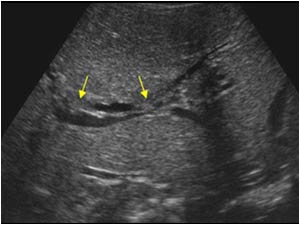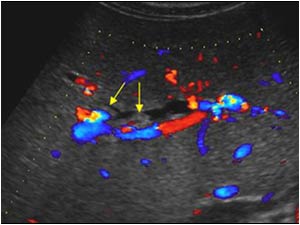4 weeks old female
Jaundice


All the structures in the biliary tract show no acoustic shadowing and have the appearance of inspisated bile and sludge balls.
The patient was referred to a pediatric university center. The diagnosis was confirmed: Biliary tract dilatation caused by inspisated bile and sludge balls.
Because the patient was treated with antibiotics for a urinary tract infection prior to the onset of the jaundice and no other predisposing factor for biliary tract sludge and stone formation was found, it was presumed that this was the cause of the sludge formation.
Common causes for biliary tract sludge and stone formation in the very young pediatric patients are parenteral nutrition, dehydration, infection and cephalosporin treatment.
The patient could be treated conservatively and the jaundice disappeared.
See also case of the month September 2005
References
Klar A, Branski D, Akerman Y, Nadjari M, Berkun Y, Moise J, Shazberg G, Revel-Vilk S, Israeli T, Katz G, Levy A, Ami AB, Hurvitz H J Sludge ball, pseudolithiasis, cholelithiasis and choledocholithiasis from intrauterine life to 2 years: a 13-year follow-up.
Pediatr Gastroenterol Nutr. 2005 Apr;40(4):477-80.